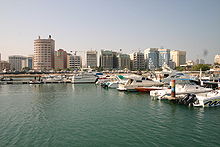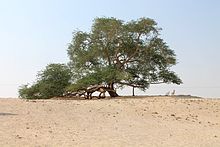Bahrain
![]()
This article is about the state. For other meanings, see Bahrain (disambiguation).
Template:Infobox State/Maintenance/TRANSCRIPTION
Template:Infobox State/Maintenance/NAME-German
The Kingdom of Bahrain [ˌbaχˈʀaɪ̯n] (also Bahrein; Arabic البحرين al-Bahrain, DMG al-Baḥrayn) is a state consisting of 33 islands in a bay in the Persian Gulf, east of Saudi Arabia and west of Qatar (about 35 km as the crow flies). With an area of around 750 km² (after artificial flushing), the archipelago is somewhat smaller than the Hamburg city area. The name al-Bahrain means "the two seas" in Arabic.
Bahrain is a moderately wealthy country. It was ranked 36th in the list of countries ranked by gross domestic product (GDP) per capita in 2019. The United Nations Development Programme ranks Bahrain among the countries with very high human development. However, the country has been rocked by conflicts between the country's Shia majority and the Sunni minority that holds political power since the start of the Arab Spring in 2011. Bahrain is a monarchy, much like Saudi Arabia, which is opposite. The ties between the two royal houses are considered close, and Saudi forces helped put down the Shia uprising in 2011. Bahrain's political system is considered repressive.
Geography
Location
The main island of Bahrain (620 km²) has an elongated shape of 48 × 16 km. It is a limestone plateau 30 to 60 m high and covered mainly by sand dunes. The island has been linked to Saudi Arabia since 1986 by a 25 km bridge, the King Fahd Causeway. In the center rises the Dschabal ad-Duchan (135 m). In the south and southwest there are sandy areas and salt marshes. Only the northern coastal area is arable due to artesian wells and karst springs. Other large islands are al-Muharraq, Sitra, Amwaj, Hawar and Umm Nasan. They are mostly rocky and barely rise above sea level.
The capital Manama is located in the northeast with a population of about 158,000. To the east is the deep-water port of Mina Salman, which is used by Bahrain's armed forces as well as cruise ships.
In many parts of Bahrain, extensive land fill has been started since the beginning of the 21st century. The total area of all offshore islands, peninsulas, new bays, etc. now amounts to around 30 km², of which only a small part has been built on. The aim is - analogous to the artificial areas in Dubai and Abu Dhabi - to gain water-washed parcels in order to build on them. Due to the real estate crisis of 2009, many construction projects are now at a standstill, such as the three Twisted Towers near Seef or the eleven Marina West high-rises in Budaiya. The skyscrapers are still under construction. Many - also western - investors lost their money.
Climate
Bahrain has a warm and humid subtropical climate with high humidity. Mainly a hot and humid wind blows from the northwest (Shamal), sometimes also a hot and dry wind from the south (Qaus) from the desert Rub al-Chali (engl.: Great Arabian Desert). The monthly average temperatures are between 17 °C (January) and 33.5 °C (July), the precipitation amounts to only 70 mm. Bahrain has a high level of particulate matter.
| Bahrain/Manama | ||||||||||||||||||||||||||||||||||||||||||||||||
| Climate diagram | ||||||||||||||||||||||||||||||||||||||||||||||||
| ||||||||||||||||||||||||||||||||||||||||||||||||
| Monthly average temperatures and precipitation for Bahrain/Manama
Source: Bahrain Meteorological Service | ||||||||||||||||||||||||||||||||||||||||||||||||||||||||||||||||||||||||||||||||||||||||||||||||||||||||||||||||||||||||||||||||||||||||||||||||||||||||||||||||||||||||||||||||||||||||||||||||
flora and fauna
The main island is dominated by desert vegetation except for the agricultural zone. The species-poor fauna consists mainly of true lizards, desert jumping mice and mongooses. Gazelles and hares are almost extinct. The Al-Aree Wildlife Park and Reserve serves the protection of different animal groups and could achieve a successful reintroduction of endangered antelope species such as the goitered gazelle (Gazella subgutturosa, Arabian sand gazelle). Bahrain's forest area has the highest percentage increase in the world, 14.9% between 1990 and 2000, and is famous for the Shadsharat al-Haya (Tree of Life), a centuries-old large tree in the desert that is considered a natural wonder.
Bahrain signed the Convention on Biological Diversity (CBD) in 1996, but not the Nagoya Protocol, which regulates the equitable sharing of benefits between rich and poor states in matters of nature conservation (access & benefitsharing).

Manama, capital of Bahrain

The Shacharat al-Haya (Arabic شجرة الحياة, DMG šaǧarat al-ḥayāh 'tree of life'), a 400-year-old mesquite tree of the species Prosopis cineraria (Khejribaum), considered a natural wonder.
Population
Demographics
Of the island nation's 1.3 million residents in 2013, 614,830 were residents and 638,361 were immigrant foreigners (2013 Census). As of March 2012, there were 371,183 foreigners in employment, according to the Labour Market Regulatory Authority (LMRA). In 2017, 48.4% of the population were migrants.
Indians lead with 192,500 people, followed by 71,915 Bangladeshis, 32,443 Pakistanis, 21,661 Filipinos, 16,294 Nepalese, 6470 Egyptians and 5254 Ceylonese. In addition, there are also Bidun, stateless people of Arab origin. Bidun status is inherited and results in significant social discrimination. The private sector employed 351,314 foreigners, 329,165 men and 22,149 women. In the first quarter of 2011, there were still 453,661 foreigners employed in Bahrain. The foreign workers had 82,000 dependents, 33,801 spouses and 49,026 children.
27.5% of Bahrainis were under 15 years old in 2004. Population growth averaged 2.4% between 1994 and 2004, life expectancy was 76.4 years in 2015, and the proportion of urban population was 90% in the same year. Bahrain's largest cities (as of 1 January 2011) are Manama (158,000 inhabitants), Ar-Rifā' al-Gharbi (117,000 inhabitants), al-Muharraq (109,000 inhabitants), Madīnat Hamad (85,000 inhabitants), A'ali (66.000 inhabitants), Sitra (42,000 inhabitants), Madinat Isa (41,000 inhabitants), al-Budayyi' (38,000 inhabitants), Jidhafs (35,000 inhabitants), al-Malikiyya (16,000 inhabitants), and al-Hidd (15,000 inhabitants).
See also: List of cities in Bahrain
| Population development | |
| Year | Inhabitants |
| 1950 | 0116.000 |
| 1960 | 0162.000 |
| 1970 | 0213.000 |
| 1980 | 0360.000 |
| 1990 | 0496.000 |
| 2000 | 0665.000 |
| 2010 | 1.241.000 |
| 2019 | 1.641.000 |
Source: UN
Languages
The official language is Arabic, while English is widely used as a language of education and commerce. Other languages are Persian and Urdu.
Religion
Islam, to which 70.2% of the total population (including foreign nationals; as of the 2011 census) belong, is the state religion. The majority of Bahraini citizens are Shiite - unlike in neighbouring Arab states, but just as in the neighbouring Saudi eastern province of ash-Sharqiyya. The ruling house itself is Sunni.
The 2001 census revealed a share of 9 % Christians in the total population and 9.8 % followers of other faiths, especially Hinduism. The 2011 census only surveyed the proportion of non-Muslims, without distinguishing between individual non-Islamic religions and atheists. Bahrain still has a small community of about 30 Jews and is the only Arab country in the Persian Gulf with a synagogue for the Jewish community.
Questions and Answers
Q: What is Bahrain?
A: Bahrain is an island country located in the Arabian Gulf.
Q: Which country is Bahrain connected to by the King Fahd Causeway?
A: Bahrain is connected to Saudi Arabia by the King Fahd Causeway.
Q: Which country is located to the south of Bahrain?
A: Qatar is located to the south of Bahrain across the Persian Gulf.
Q: What is the Qatar-Bahrain Friendship Bridge?
A: The Qatar-Bahrain Friendship Bridge is a proposed bridge that will link Bahrain to Qatar as the longest fixed bridge in the world.
Q: Are Qatar and Bahrain's flags the same design?
A: Yes, Qatar and Bahrain's flags have the same design.
Q: Are Qatar and Bahrain's flags the same colors?
A: No, the colors of the flags are different, with Qatar's flag being white and maroon, while Bahrain's flag is white and red.
Q: What is the official name of Bahrain?
A: The official name of Bahrain is Kingdom of Bahrain.
Search within the encyclopedia